I was recently watching a Season 2 episode of “Designated Survivor” and the closing scene showed President Kirkman and his brother standing at the grave of the First Lady who had died a few episodes earlier. As the camera panned away and the cemetery came into view, I realized I could use the cemeteries as a theme for a story about my trip. By “my trip” I’m referring to the cross-country trip I took this past July to do memorial services at the graves of our eleven USMA 1969 classmates who fell in Vietnam and who are not buried at West Point.
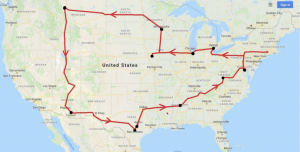
The final service for the eight buried at West Point was held in late November. Such a theme may put some potential readers off, but as a pastor part of my job is to help people to find peace with God in the face of death. With that in mind, bear with me as I reflect on the semi-final resting places of our classmates.
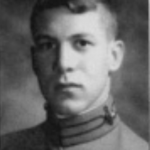
Grand Lawn Cemetery, Detroit, Michigan: Detroit is known as a place that was once a great city but is now a decaying relic of its past greatness. Grand Lawn Cemetery rests in the presence of some of that decay, but as its name suggests, it is a lovely reminder of what the city once was. At about 30 city blocks, it is a large cemetery, and Barry McGee’s grave is under a small tree in Section 27, which is in the far right-hand corner of the cemetery. The section is about the size of two football fields end-to-end with no upright grave markers. The flat marker was all by itself with no obvious evidence of other family members being buried nearby. It was covered with dirt and small branches and some overgrown grass, which is what you might expect with no known next of kin. However, when the nine of us who attended left after the service, the marker looked presentable and should remain so for a little while longer. To read Barry McGee’s Memorial Article, click here.
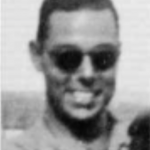
Ridgelawn-Mt. Mercy Cemetery, Gary, Indiana: As cemeteries in bigger cities go, Ridgelawn-Mt. Mercy is probably just about as typical as they come. It consists of a rectangular tract of land bordered by West Ridge Road on the north and West 41st Avenue on the south; and it rests in a fairly ordinary residential/commercial area of the city. It is well-maintained which is what you would hope for your loved-one’s final resting place. Terry O’Boyle’s grave is in a family plot bordering on a secondary lane leading into the cemetery from West Ridge Road. As with Barry McGee, there were no known next of kin, which perhaps explains why the family plot was neatly kept, but the grass around Terry’s flat marker was a bit overgrown. So much so that when I asked a cemetery worker to help me find it I discovered that I was almost standing on top of it. Unlike national military cemeteries which are all beautifully kept, I did wonder as we five classmates left, who will clean the overgrown grass off Terry’s marker the next time? To read Terry O’Boyle’s Memorial Article click here.

Oak Hill Calvary Cemetery, Corning, Iowa: As is probably the case with many small towns in America, Oak Hill Cemetery sits by itself on a rectangular plot of land just outside and in this case just south of the Corning town limits. It was not as impressive as some, but it had obviously been around for a while. Certainly long enough to have an ample grove of trees and green grass and to be nicely presented. Ed Northup’s grave was in a family plot at the top end of a slowly rising slope. This portion of Iowa is not altogether flat, which meant that it was possible to look around and see some scenery as we waited for people to arrive. One thing that can be said for small town America is that though they may not always have magnificent cemeteries, their people have big hearts as that little cemetery made room for the second largest turnout on the trip with just over 30 people in attendance. Ed’s service was one where I was not able to spend the night in the immediate vicinity the night before. It was about an hour and a half drive to Corning from Des Moines, and then an hour and a half back before I could head off for my next destination. It meant that it was the only time where I did not get to spend any time exploring the grounds a little bit. I would have liked to have done that. To read Ed Northup’s Memorial Article click here.
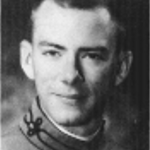
Fort Snelling National Cemetery, South Minneapolis, Minnesota: This was a big, beautiful cemetery with over 200,000 graves; and it was meticulously maintained. I drove around and took pictures from several different vantage points, with each picture containing row upon row of graves as far as I could see, and with no grave being repeated in any of the pictures. Perhaps it was because this was the first national cemetery on my trip, but I was quite moved being in the presence of so many veterans’ graves. I also felt a great sense of patriotic pride as I looked around at the wonderful effort, we as a country put into remembering our fallen heroes. Art Nabben also has no next of kin, but finding his grave was not very difficult for the six of us attending. The cemetery has great online information, so it was very easy to find his individual grave in Section P, even in the midst of thousands of other identical graves. Also, there will be no need to worry that his grave will not be presentable the next time someone looks for it just north of the center of the cemetery. To read Art Nabben’s Memorial Article click here.
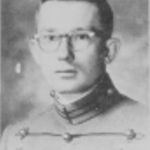
Choteau Cemetery, Choteau, Montana: In a way, the Choteau Cemetery reminded me of the one in Corning, Iowa. The one difference would be that instead of being a small plot of land on the south side of town it was located to the east of town. That and the fact that it was a flat plot of land rather than slightly sloping. However, that did not mean that there was no scenery to be had. In Iowa you needed to be on a rise to see any scenery, but in Montana the scenery rose up all around you demanding to be looked at. I remember as I was approaching town from the south and seeing a butte rising up from the valley off to the left. As I passed by, I looked up and imagined that as a kid Tom Dellwo must have ventured off with some friends to climb that butte to see what they could see of the rest of the world from the top. As I was standing in the cemetery behind Tom’s grave leading the service I was facing south and made reference to the butte off in the distance and mentioned my imaginings. That little cemetery in Choteau was the furthest point north in my travels and the place of the largest gathering with just over 35 present. After that, it was time to head south towards Arizona. To read Tom Dellwo’s Memorial Article click here.
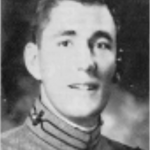
Holy Hope Cemetery, Tucson, Arizona: Normally when you think of cemeteries you think of green grass and maybe gentle slopes and curvy little lanes that weave their way through the gravestones. Don’t bother trying to think of such things in Tucson, Arizona. No one living there pretends that grass is normal, not in their back yards nor in their cemeteries. What they do imagine to be normal in July is temperatures over 100° as a matter of course. I was told by more than one person not to wear a coat and tie for the service, which I had planned to do at all of them. So, I didn’t. Instead, I wore a USMA golf shirt which I ordered by phone while driving across North Dakota and had shipped from West Point to Tucson. As it turned out all that special effort to stay reasonably cool beside Bill Pahissa’s grave was totally unnecessary. There among the semi-reddish sandy soil and under a fairly large but scraggly tree, and on an unseasonably mild day, I experienced the nicest weather of all the services on the whole trip. Standing there with 13 others also represented the further point west in my travels. To read Bill Pahissa’s Memorial Article click here.
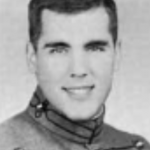
Fort Sam Houston National Cemetery, San Antonio, Texas: Having just written about the nicest weather, I suppose at some point I need to mention the not so nicest weather. You might expect that at some point that would have involved a thunder storm, but that did not ever turn out to be the case. Rather, the weather that was the hardest for me to deal with was the scorching sun and heat. And I think that the epicenter of that occurred next to George Bass’ grave in San Antonio, Texas. I knew the day was going to be hot before I ever arrived at the cemetery; but as I arrived, I hoped that we might find shade under one of the many trees that were everywhere to be seen. Such was not to be the case. Section X was equaled in size only by Section W, and with well over 2,500 graves it actually offered great hope with a fair number of trees to be seen spread around the section. But alas, George’s grave was right in the middle of the largest open space in the section offering no hope of rescue from the sun which made its presence felt the moment the 15 of us stepped out of our cars. Perhaps that was to be expected of the southernmost point in my travels. To read George Bass’ Memorial Article click here.
Ray,
Wonderful tributes.
Hope you mend well from your bike accident–we look forward to your words at the 12 October 2019 Memorial Service at the Vietnam Wall.
Thanks, Geoff. I look forward to being there.
Ray, thanks for sharing this from your tribute to our fallen classmates not at West Point. Great to speak with you before our reunion. As you know, the memorial service was heartfelt. I will be in touch. See you in October.
I look forward to seeing you too, Bruce … but this time it will be as two brothers in the Lord.
Ray,
Thanks for honoring our classmates. Memorial Day is a good day to look back.
Dear Ray:
Thanks! This article can also be found at your section on the Class Events page at https://www.west-point.org/class/usma1969/Events.htm
Best regards,
Bill
Ray,
Thanks again for honoring our classmates.
Ray. this has been a terrific memory of our classmates, and is greatly appreciated by all of us.
Thank you.
Thanks for these remembrances, Ray…I am especially touched by the ones without relatives whose graves are left uncared for…best, Rick
Ray,
Thank you for this great tribute to. The fallen BOTL!!
God Bless,
Stan
Ray,
Thank you once again for the tremendous labor of love and tribute to our brothers you accomplished.
Pete
Ray, again excellent tribute to our fallen classmates. I was in country exactly 50 years ago during the Easter Offensive of 1972. I was one of the lucky ones- I made it back. The one thought I had at the beginning of my tour in November 1971, was “it’s a good thing the war is winding down and things are calmer. Maybe I’ll get a 60 day drop.” Not exactly what happened. And all for what?